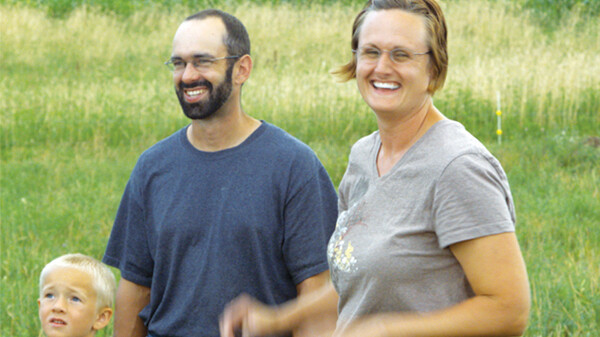Hog Heaven
The Deutsch family of Osseo says organic farming, outdoor living are the keys to tastier pork

Years of big-budget marketing have convinced Americans that pork is “the other white meat.”
Jim Deutsch of Deutsch Family Farm begs to differ. “We say it’s the other red meat,” explains Deutsch, who raises several hundred pigs with his wife, Alison, and their two young children on an organic farm outside Osseo. From the breeds of animals the Deutsches raise to how those animals live and eat – and, ultimately, to the pork chops on your plate – the family’s 160-acre operation harkens back to an earlier era of agriculture. “The meat in the older breeds (of pig) is a redder meat,” explains Jim. “It’s not that pale white that’s so common in commercial pork.” That natural coloration sometimes causes concern among first-time customers who are afraid they haven’t cooked the meat thoroughly. Educating customers – who get pork and poultry directly from the Deutsches or via several local grocers and restaurants – is essential when it comes to the heirloom breeds and traditional farming methods the family uses. “Most people really aren’t aware of how their food is produced,” Jim says.
What factors set a farm like theirs apart from a typical pork producer? “The biggest one would be the outdoors,” Jim says. “A typical hog farm today is completely indoors. Probably the second biggest different is the space. Ours has so much more space per animal. … The other difference would be the feed. We raise it all, mix it all, and grind it ourselves.”
“Probably the biggest key to our pork is the sun,” farmer Jim Deutsch says. “The sun does a lot for the taste of the meat and the health of the animal.”
The hogs dine on barley, corn, alfalfa, rye, and oats raised in the farm’s certified organic fields – as well as whatever else they find as they root about outside. The Deutsches raise three traditional breeds – Hampshire, Duroc, and Berkshire – that are also found in some convention operations, although the Deutsch animals carry older genetics. “The modern pig has been bred to be super lean, so a modern pig wouldn’t be able to survive in our setup,” Jim says. “Ours are outside year round, so they have to have that extra fat on them.”
The Deutsches employ what is known as a Swedish deep-bedding system for their animals, providing an open-sided building filled with several feet of straw and cornstalks where the animals can bed down and engage in their natural rutting behavior. After they are bred, sows are kept together outside; during and after farrowing – that’s the porcine term for giving birth – the sows and their piglets are kept in pens, not crates. Later, all the piglets and sows are grouped together, which isn’t standard practice but which the Deutsches feel is better for the animals’ welfare and behavior. Once the piglets are weaned, they are separated from the sows but kept in a barn until they are over the stress of the process. After that, they’re on their own with food and water outdoors. “Probably the biggest key to our pork is the sun,” Jim says. “The sun does a lot for the taste of the meat and the health of the animal.”

And the Deutsches are firm believers that such agricultural methods are better for the health of those who eat the final product, too. The couple’s journey into organic farming began when Jim, a former tool and die maker, developed health problems that he says improved after changing his diet. While neither Jim nor Alison grew up on farms, farming was in their blood. Seven years ago they began raising pigs, first on another family’s farm in eastern Minnesota, then on rented property in western Wisconsin, and finally on their current farm, a former dairy operation they bought in 2010. The land itself is now certified organic, meaning – among other things – that they don’t use pesticides, herbicides, or genetically modified crops. The pork itself is not certified organic (that would require additional cost and paperwork, Jim explains), but it is produced without the antibiotics and growth hormones often used on conventional farms.
“Raising any kind of animal has challenges,” Jim says. “The challenges we have would be management challenges. We’re not using antibiotics to solve problems, so we have to manage everything for prevention.”
Such traditional methods lead to better-marbled, more delicious meat, says Nik Novak, the meat buyer at Just Local Food Cooperative in Eau Claire, which is among several western Wisconsin stores to carry Deutsch Family Farm products. “Eating industrial meat is like eating nothing but iceberg lettuce,” Novak opines. By contrast, he says, dining on meat like that raised by the Deutsches “is like switching over to kale all of a sudden.”
Market trends indicate such heartier, more natural fare is increasingly popular. According to the U.S. Department of Agriculture, organic food sales blossomed from $11 billion to $25 billion between 2004 and 2011. Meanwhile, a major meat industry survey found that the share of consumers who said they had purchased natural or organic meat in the past three months grew from 26 percent in 2013 to 34 percent this year.
In turn, such buying decisions – driven by shifting ecological, ethical, and health considerations – are having an impact for farmers and retailers. “Most people want to know what the animal eats,” says Novak when asked about Just Local’s meat shoppers. “They want to know if they’re happy, fell-fed animals. They’re looking for solace and peace of mind.”
To learn more about Deutsch Family Farm, visit deutschfamilyfarm.com or search for Deutsch Family Farm on Facebook. To view an episode of the TV program Around the Farm Table featuring the farm, go to aroundthefarmtable.com/videocase/ and click on “Episode 2: A Picnic in the Pasture.”


















